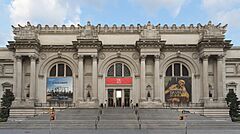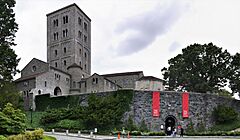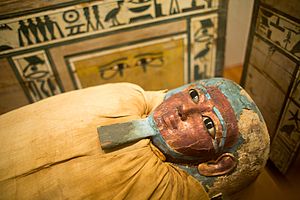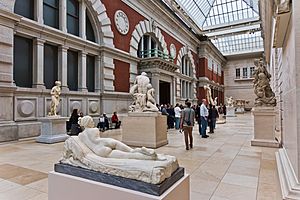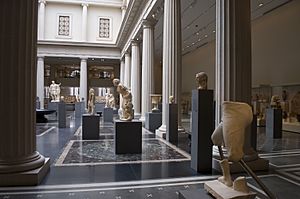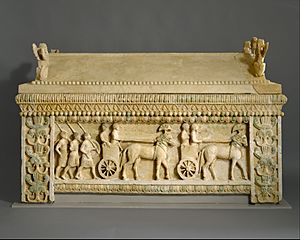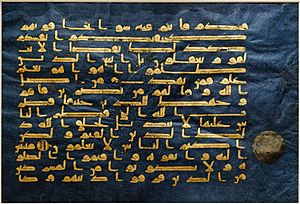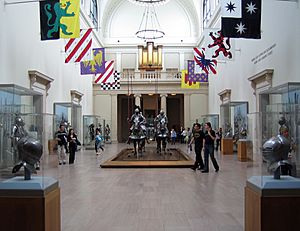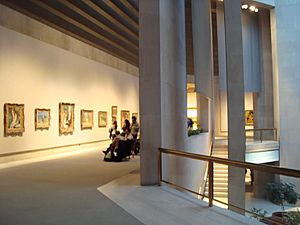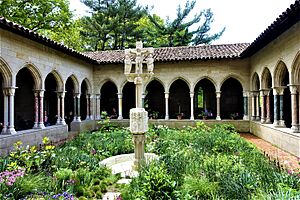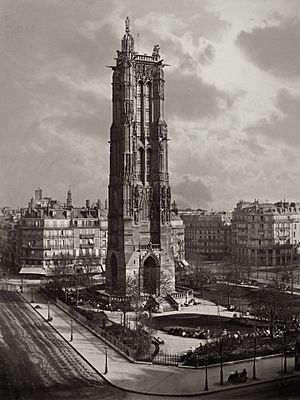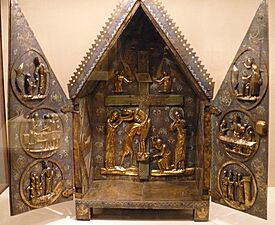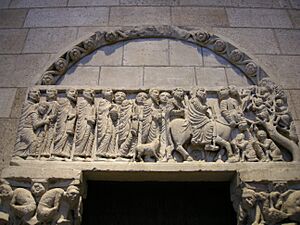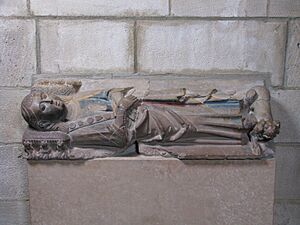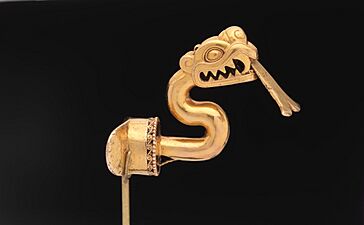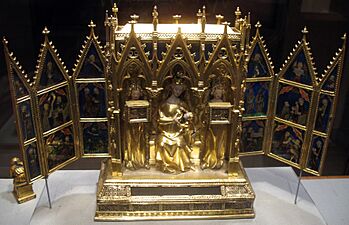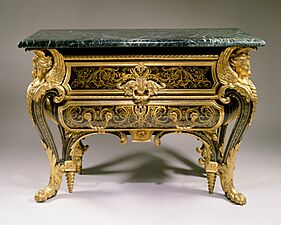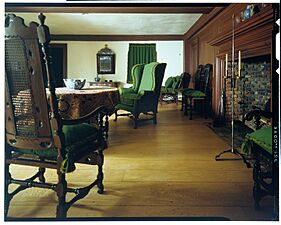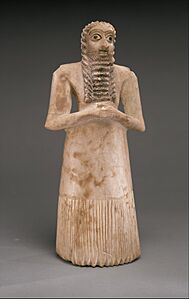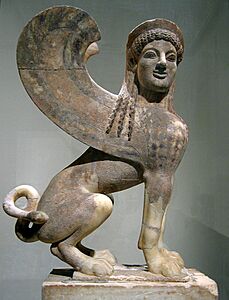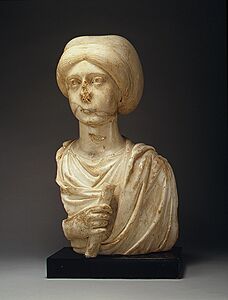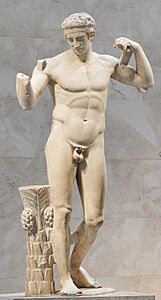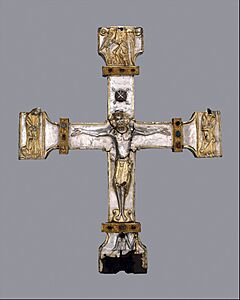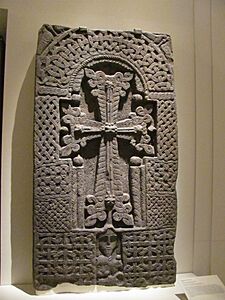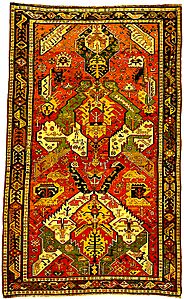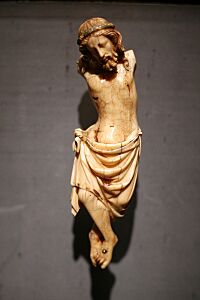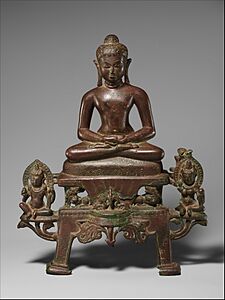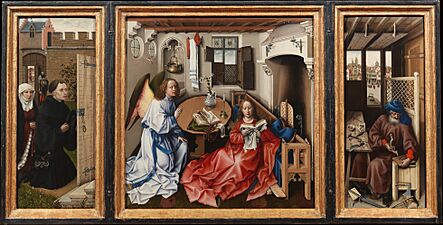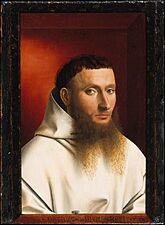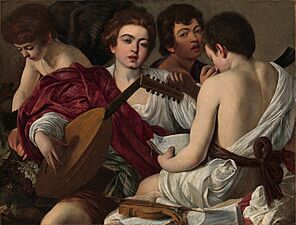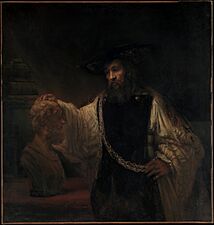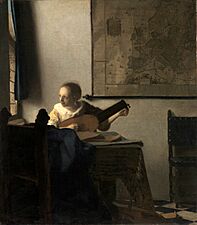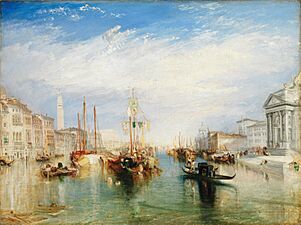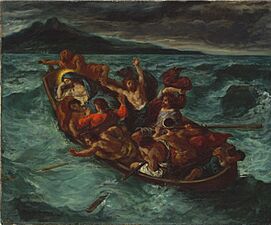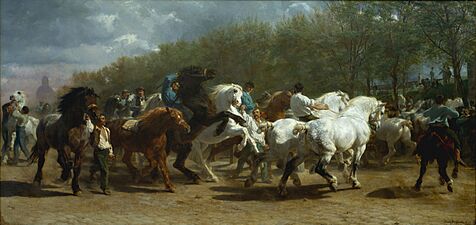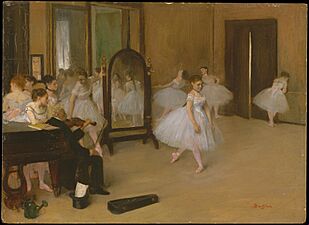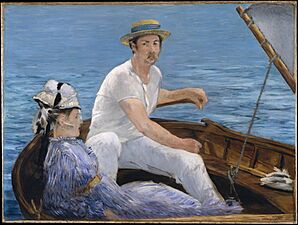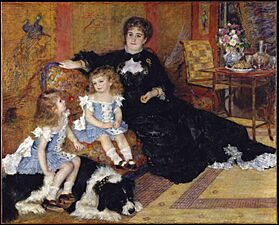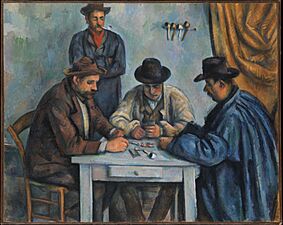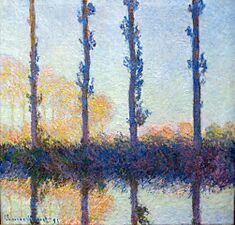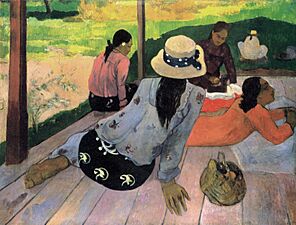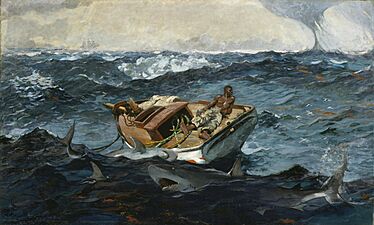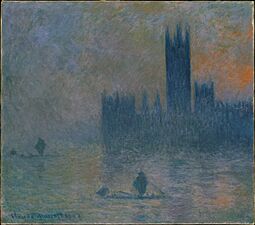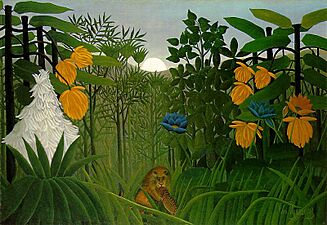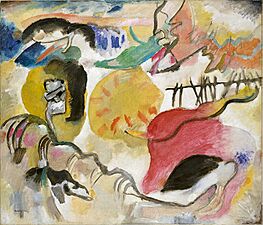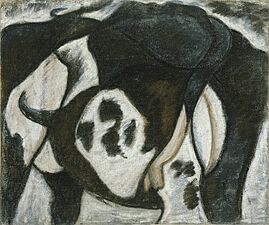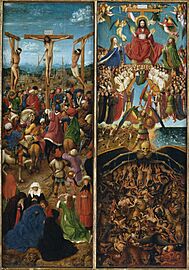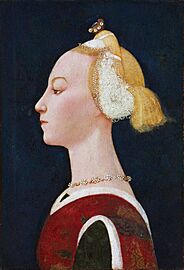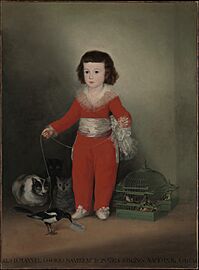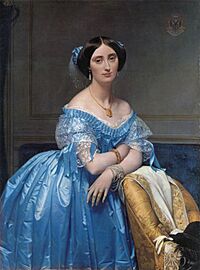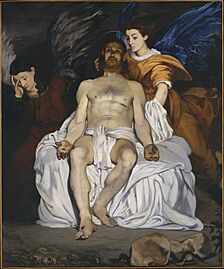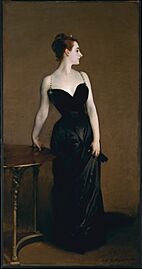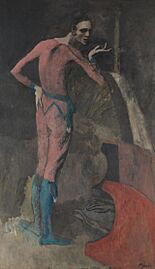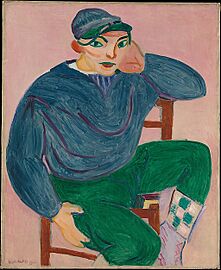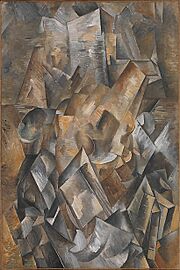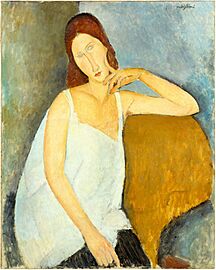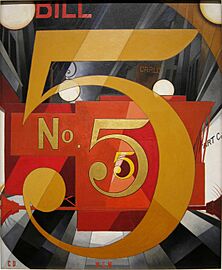Metropolitan Museum of Art facts for kids
 |
|
|
Entrance façades to The Met Fifth Avenue and The Cloisters
|
|
| Established | April 13, 1870 |
|---|---|
| Location | 1000 Fifth Avenue (The Met Fifth Avenue) 99 Margaret Corbin Drive (The Cloisters) New York City, New York, U.S. |
| Type | Art museum |
| Collection size | 2 million |
| Visitors | 5.364 million (2023) |
The Metropolitan Museum of Art, often called the Met, is a huge art museum in New York City. It's one of the largest museums in the world and the biggest art museum in the Americas. In 2023, over 5.3 million people visited, making it the most popular museum in the United States.
The Met has a massive collection of over 1.5 million artworks. These pieces are organized into 17 different departments. The main building, located at 1000 Fifth Avenue next to Central Park, is enormous. A smaller, special location called The Cloisters is in Fort Tryon Park. It focuses on art, architecture, and items from medieval Europe.
The Metropolitan Museum of Art started in 1870. A group of Americans, including artists and business leaders, wanted to create a place to inspire and teach the public through art. The museum's collection covers art from ancient times to today. It includes paintings, sculptures, and drawings from many cultures. You can find art from ancient Near East, ancient Egypt, classical antiquity, Europe, America, Africa, Asia, and the Islamic world. The Met also has collections of musical instruments, costumes, and weapons and armor from all over the globe.
Contents
Exploring the Met's Amazing Collections
The Met's huge collection is looked after by seventeen different departments. Each department has experts called curators and scholars. There are also special teams that work to keep the artworks in good condition. The collection includes art from ancient times, European masterpieces, and modern art. You can also find art from Africa, Asia, Oceania, and the Islamic world. The museum also has collections of musical instruments, costumes, and antique weapons. Many galleries feature "period rooms" that show how people lived in different times, from ancient Rome to modern America.
Art from Around the World
Ancient Near Eastern Art
The Met began collecting art from the Near East in the late 1800s. What started with a few ancient tablets has grown to over 7,000 pieces. This collection shows the history of the region from the Stone Age to the end of ancient times. It includes art from cultures like Sumerian, Hittite, Assyrian, and Babylonian. Some famous items are the Sumerian Stele of Ushumgal and huge stone guardian figures called lamassu.
Art from Africa, Oceania, and the Americas
The Met started seriously collecting art from Africa, Oceania, and the Americas in 1969. This happened when Nelson Rockefeller, a businessman and former New York Governor, donated his collection of over 3,000 pieces. This art is now displayed in "The Michael C. Rockefeller Wing." This wing is named after Nelson Rockefeller's son, Michael Rockefeller, who passed away while collecting art in New Guinea.
Today, this wing holds over 11,000 artworks from sub-Saharan Africa, the Pacific Islands, and the Americas. These pieces date from 3,000 BCE to today. This collection helped change how people viewed these objects. Before, they were often seen as "primitive" or just historical items, not fine art. The collection includes ancient Australian rock paintings and tall memorial poles from New Guinea.
Asian Art
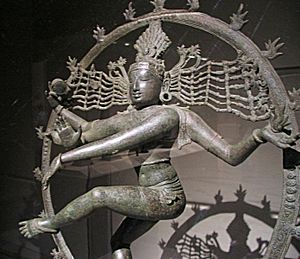
The Met's Asian art department has more than 35,000 pieces, making it one of the best collections in the U.S. This collection covers 4,000 years of Asian art history. You can see paintings, prints, sculptures, and metalwork from major Asian civilizations. The department is known for its art from Cambodia, India, and China, including beautiful calligraphy and paintings. It also features art from Nepal, Tibet, and Thailand. The Asian wing even has the Astor Court, a peaceful Chinese garden courtyard.
Ancient Egyptian Art

Almost half of the Met's Egyptian art comes from its own archaeological digs between 1906 and 1941. The collection has over 26,000 pieces from ancient Egypt, from the Stone Age to the Ptolemaic era. Most of these are on display in 40 Egyptian galleries. One famous item is William the Faience Hippopotamus, a small statue that has become a mascot for the museum.
The most popular part of the Egyptian collection is the Temple of Dendur. This large sandstone temple was given to the United States by Egypt in 1965. It was moved to save it from rising waters caused by a new dam. The temple was rebuilt in a special wing at the Met in 1978. It sits in a large room with a reflecting pool and big windows looking out onto Central Park.
European Paintings
The Met has over 2,600 European paintings from the 13th to the early 20th century. These paintings are in several galleries on the second floor of the main building. Some medieval paintings are also at The Cloisters. The collection started in 1871 with 174 paintings. Over the years, many generous gifts from collectors like Benjamin Altman and Jules Bache helped it grow.
The museum has an amazing collection of Impressionist and Post-Impressionist art. This includes works by famous artists like Claude Monet, Paul Cézanne, and Vincent van Gogh. The Met's collection of 19th-century French paintings is considered one of the best outside of Paris.
European Sculpture and Decorative Arts
This is one of the Met's largest departments, with over 50,000 items from the 15th to the early 20th centuries. It has many Renaissance sculptures, furniture, jewelry, glass, ceramics, and textiles. Visitors can explore dozens of fully furnished "period rooms" that were moved into the museum. A highlight is an entire 16th-century patio from a Spanish castle, rebuilt in a two-story gallery.
American Wing

The American Wing showcases the history of American art from the 18th to the early 20th century. In 2012, new galleries opened, covering 30,000 square feet. In 2018, "Art of Native America" opened, featuring Indigenous American art for the first time in this wing. The museum is working to acknowledge and respect the original communities whose art it cares for.
Greek and Roman Art
The Met's collection of Greek and Roman art has over 17,000 objects. The very first item the museum ever acquired was a Roman sarcophagus, which you can still see today. The collection includes items from ancient Greece and the Roman Empire, showing many different styles.
Highlights include the huge Amathus sarcophagus and a detailed Etruscan chariot. There are also very old Cycladic sculptures from thousands of years ago. The Greek and Roman galleries were expanded in 2007, so most of the collection is now always on display.
Islamic Art
The Met has one of the world's largest collections of art from the Islamic world. This includes items from the Near East, North Africa, and Central Asia. The collection isn't just religious art; it also has many everyday items like ceramics and textiles. A special part of the collection is the miniature paintings from Iran and Mughal India. Beautiful Calligraphy is also well-represented.
The Islamic Art galleries were renovated and reopened in 2011. They include reconstructed interior pieces, like the Nur Al-Din Room from an 18th-century house in Damascus. In 2022, the museum received a big gift from Qatar Museums, and a gallery was named the Qatar Gallery to celebrate this partnership.
Special Collections
Arms and Armor
The Met's Department of Arms and Armor is very popular. It has pieces from the late medieval Europe and Japan, known for their amazing craftsmanship. But it also includes weapons and armor from ancient Egypt, Greece, Rome, Africa, and the Americas. Among the 14,000 objects are some of the oldest items in the museum, like flint tools from 700,000 BCE. You can also see armor made for kings like Henry VIII of England. The famous display of armored figures on horseback is a recognizable image of the museum.
Costume Institute
The Costume Institute has over 35,000 costumes and accessories. Because these items are very delicate, they are not always on permanent display. Instead, the Institute holds two special exhibitions each year, focusing on a designer or a theme. The Costume Institute is also famous for hosting the annual Met Gala, a big event in the fashion world. Past exhibits have explored rock style, ideas of beauty, and the history of American fashion.
Drawings and Prints
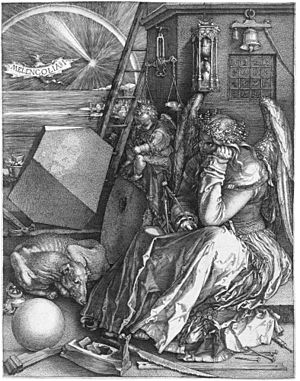
This department focuses on drawings and prints from North America and Western Europe after the Middle Ages. It has about 21,000 drawings, 1.2 million prints, and 12,000 illustrated books. Many famous European painters, who made more sketches than actual paintings, are represented here. The collection also includes photographs, architectural drawings, and posters.
Robert Lehman Collection
When banker Robert Lehman passed away in 1969, his family donated 2,600 artworks to the museum. This collection is housed in the "Robert Lehman Wing." It's considered one of the most amazing private art collections ever brought together in the United States. The collection shows Lehman's personal interests, with a strong focus on Italian Renaissance paintings. It also includes many drawings by Old Masters like Rembrandt and Albrecht Dürer.
Medieval Art and The Cloisters
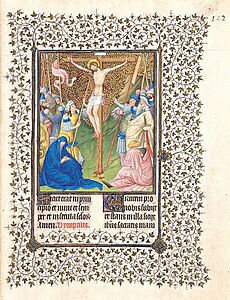
The Met's medieval art collection covers Western art from the 4th to the early 16th centuries. It also includes Byzantine and pre-medieval European items. This collection has over 10,000 objects, split between the main museum building and The Cloisters.
Medieval Art in the Main Building
The main building's medieval collection has about 6,000 objects. It displays a lot of Byzantine art alongside European pieces. You can see tapestries, church statues, and smaller items made of precious metals and ivory. The main gallery, with its high arched ceiling, is also where the Met's famous Christmas tree is displayed each year.
The Cloisters Museum and Gardens
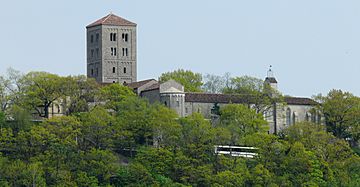
The Cloisters is a separate museum dedicated only to medieval art. It was a major project of John D. Rockefeller Jr., a big supporter of the Met. Completed in 1938, The Cloisters is named after five medieval French cloisters (covered walkways) that were brought from Europe and built into the modern museum. Its 5,000 objects include the beautiful Belles Heures of Jean de France, Duc de Berry and the famous "Hunt of the Unicorn" tapestries.
Modern and Contemporary Art
This collection has about 13,000 artworks, mostly by European and American artists. It includes famous pieces like Picasso's portrait of Gertrude Stein and Jackson Pollock's Autumn Rhythm (Number 30). In 2013, the museum received a huge donation of Cubist art from cosmetics tycoon Leonard Lauder, including works by Pablo Picasso and Georges Braque.
Musical Instruments
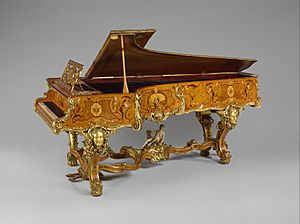
The Met's collection of musical instruments is very special, with about 5,000 examples from all over the world. It started in 1889 with a gift from Mary Elizabeth Adams Brown. The instruments are chosen not just for their beauty but also for what they teach us about different cultures. Highlights include several Stradivari violins and the oldest surviving piano, made in 1720. Many instruments can still be played, and the museum holds concerts and demonstrations.
Photographs
The Met's photography collection has over 25,000 photos. It grew from major donations by photographers like Alfred Stieglitz and other important collections. The department of photography was created in 1992. Because photographs are delicate, not all of them are always on display. The department often creates popular temporary exhibits, like a show on Diane Arbus.
Digital Access to Collections
Since 2013, the Met has worked to make its collections available online. In 2017, it launched its Open Access initiative. This made over 375,000 images of public-domain artworks available for anyone to use for free. This has allowed millions of people to view and download images from the Met's archives.
Libraries for Learning
The Met has several libraries. Two of them are open to the public without an appointment.
Thomas J. Watson Library
This is the main library for the museum's staff and researchers. It has about 900,000 books, exhibition catalogs, and journals. It also has a collection of rare books. Anyone 18 or older can use it by registering online.
Nolen Library
The Nolen Library is open to everyone. It has about 8,000 items, including books, picture books, DVDs, and videos. There's a special children's reading room and resources for teachers.
Special Exhibitions
The Met regularly hosts exciting special exhibitions. These often feature artworks loaned from other museums and collections. These shows are a big draw for visitors. They might focus on a single artist, a specific art movement, or historical artifacts. Exhibitions usually last for several months and offer a deeper look into art's cultural impact.
Live Performances
The museum's Department of Live Arts creates new performances. These include music, sound, and movement. These performances, called MetLiveArts, happen in the museum's galleries and at The Cloisters. They are also available online through platforms like YouTube.
History of the Met
How it Started
The Metropolitan Museum of Art was officially created on April 13, 1870. Its goal was to create a museum and library of art, encourage the study of fine arts, and educate the public. The founders included important people like Theodore Roosevelt Sr., the father of a future U.S. president. They wanted to bring art and art education to the American people.
The museum first opened on February 20, 1872, at 681 Fifth Avenue. John Taylor Johnston, a railroad executive, was its first president. The museum's early collection quickly grew too big for its first home. It moved to a new building on West 14th Street in 1873. By 1880, it moved into its current building in Central Park.
The Met in the 20th and 21st Centuries
The Met is believed to have opened the world's first museum shop in 1908. In 1954, it started a series of concerts and lectures, which grew into a program of 200 events each season. Many famous performers and speakers have appeared there.
In the 1960s, Robert Lehman donated nearly 3,000 artworks to the Met. This collection is housed in the Robert Lehman Wing, which opened in 1975. The museum celebrated its 100th anniversary from 1969 to 1971 with many special events and exhibitions.
In 2018, the museum changed its admission policy. Most visitors who don't live in New York state or are not students from New York, New Jersey, or Connecticut now pay $25 to enter. New York state residents can still pay what they wish.
In 2020, the museum temporarily closed due to the COVID-19 pandemic. This was the first time in over a century it closed for more than three days. It reopened later that year with safety measures. In 2021, the Met received a huge $125 million donation from Oscar L. Tang and Agnes Hsu-Tang. The museum named its modern and contemporary art galleries after them.
The Met's Architecture
The Met's main building is located in Central Park. The first part of the museum was designed by Calvert Vaux and Jacob Wrey Mould. The famous Fifth Avenue facade, Great Hall, and Grand Stairway were designed in the Beaux-Arts style by Richard Morris Hunt and his son. The modern glass sides and back of the museum were added later.
The Met Fifth Avenue building is almost a quarter-mile long and has over 2 million square feet of floor space. It's made up of more than 20 different structures. The City of New York owns the building and helps with some of the costs. The museum's main building is a recognized landmark for its impressive architecture and cultural importance.
How the Met is Managed
The Met is run by a board of trustees. These trustees, along with city officials, help guide the museum. The museum also has an endowment, which is a fund that provides income for its operations.
Returning Art to Its Home
The Met has faced challenges regarding some of its artworks. There have been questions and lawsuits about items that might have been taken from archaeological sites without permission. Since the 1990s, the Met has worked to address these issues. It has returned hundreds of ancient items to countries like Italy and Turkey.
In 2022, New York law enforcement seized 27 ancient artifacts from the Met. These items, from Rome, Greece, and Egypt, were linked to known art traffickers and were returned to their home countries. In 2023, the museum announced it would return 14 Khmer sculptures to Cambodia and 2 to Thailand after finding they were stolen.
The museum has also faced questions about its collection of Indigenous American art. Some objects, especially funerary items, have unclear ownership histories. The Met is working with tribal governments to ensure these items are displayed respectfully or returned according to laws like the NAGPRA.
In February 2025, the Met announced it would return a 2,700-year-old bronze griffin head to Greece. An investigation confirmed the piece was looted before it came to the museum. The Met is now working to be more careful about how it acquires art. It has a team dedicated to researching the history of its artworks.
Selected Objects to See
-
A Serpent labret with articulated tongue from the Aztec culture, around 1300–1521.
-
A Commode by Andre-Charles Boulle (1642–1732).
-
A Khatchkar made of Basalt.
-
The Aldobrandini Tazza of the Roman emperor Vitellius, around the 1590s.
Famous Paintings to See
-
Robert Campin, the Mérode Altarpiece, around 1425–1428.
-
Rogier van der Weyden, Polyptych with the Nativity, around 1450.
-
Pieter Bruegel the Elder, The Harvesters, 1565.
-
Caravaggio, The Musicians, 1595.
-
Georges de La Tour, The Fortune Teller, around 1630.
-
Rembrandt, Aristotle Contemplating the Bust of Homer, 1653.
-
Johannes Vermeer, Woman with a Lute, 1662.
-
J. M. W. Turner, The Grand Canal, 1835.
-
Thomas Cole, The Oxbow, 1836.
-
Eugène Delacroix, Christ Asleep during the Tempest, 1853.
-
Rosa Bonheur, The Horse Fair, 1853–1855.
-
Edgar Degas, The Dancing Class, 1872.
-
Édouard Manet, Boating, 1874.
-
Pierre-Auguste Renoir, Mme. Charpentier and Her Children, 1878.
-
Jules Bastien-Lepage, Jeanne d'Arc (Joan of Arc), 1879.
-
Paul Cézanne, The Card Players, 1890–1892.
-
Claude Monet, The Four Trees, 1891.
-
Paul Gauguin, The Siesta, 1894.
-
Winslow Homer, The Gulf Stream, 1899.
-
Claude Monet, The Houses of Parliament (Effect of Fog), 1903–1904.
-
Henri Rousseau, The Repast of the Lion, around 1907.
-
Wassily Kandinsky, Improvisation 27, Garden of Love II, 1912.
-
Arthur Dove, Cow, 1914.
-
Jan van Eyck, Crucifixion and Last Judgement diptych, around 1430–1440.
-
Paolo Uccello, Portrait of a Lady, around 1450, Florence.
-
El Greco, The Vision of Saint John (1608-1614).jpg
El Greco, Opening of the Fifth Seal, 1608–1614.
-
Peter Paul Rubens, Rubens, Helena Fourment, and Their Son Frans, around 1635.
-
Francisco Goya, Manuel Osorio Manrique de Zúñiga, 1777–1778.
-
Jean-Auguste-Dominique Ingres, The Princesse de Broglie, 1851–1853.
-
Édouard Manet, The Dead Christ with Angels, 1864.
-
John Singer Sargent, Portrait of Madame X, 1884.
-
Vincent van Gogh, Self-portrait with Straw Hat, 1887.
-
Paul Cézanne, Madame Cézanne in a Red Dress, 1888–90.
-
Pablo Picasso, The Actor, 1904–05.
-
Henri Matisse, The Young Sailor II, 1906.
-
Georges Braque, Still Life with Mandola and Metronome, late 1909.
-
Pablo Picasso, Still Life with a Bottle of Rum, 1911.
-
Amedeo Modigliani, Jeanne Hébuterne, 1919.
-
Charles Demuth, I Saw the Figure 5 in Gold, 1928.
Images for kids
See also
 In Spanish: Museo Metropolitano de Arte para niños
In Spanish: Museo Metropolitano de Arte para niños


